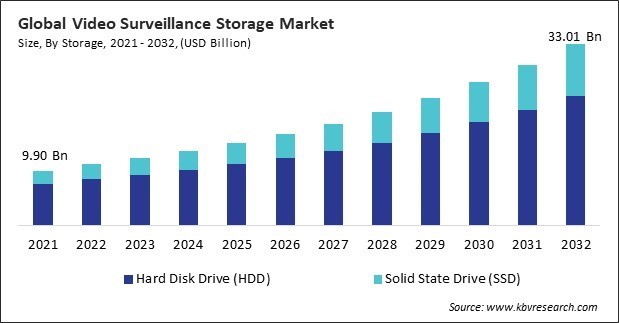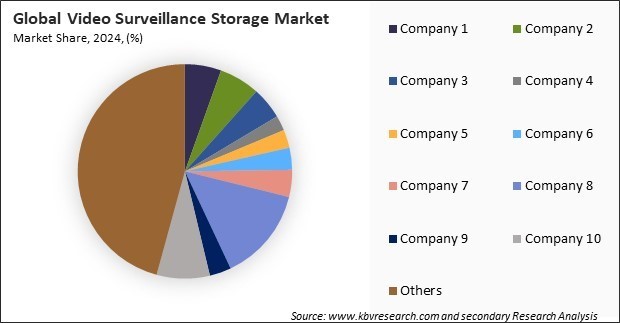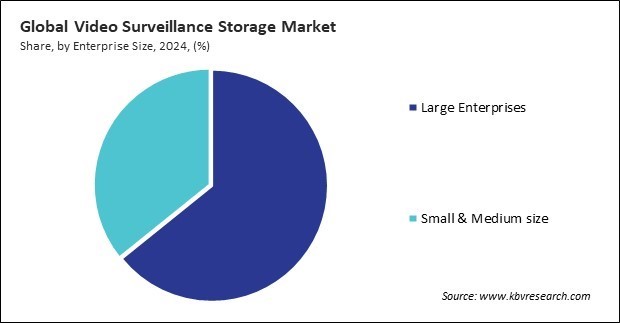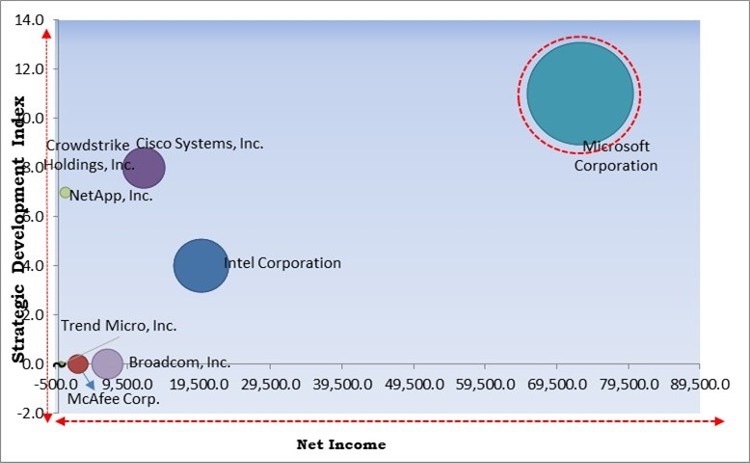The Global Video Surveillance Storage Market size is expected to reach $26.8 billion by 2028, rising at a market growth of 12.3% CAGR during the forecast period.
The practice of saving real-time video data generated by security cameras on a storage device is known as video surveillance storage. In order to evaluate the event or action as proof of the state in file or block form, the data can then be recovered at a later time. Campus safety, stadium safety, hospital and patient safety, airline safety, and police safety all use video surveillance systems. Additionally, video security cameras are utilized to record a lot of data, necessitating increased network bandwidth and storage space.

Also, factors include the increase in demand for highly effective and AI-based surveillance systems that fuel the market's expansion. The expansion of AI edge computing, analytics for security, and the emergence of the "as a service" business model all contribute to the expansion of the video surveillance storage market. The use of cutting-edge technologies like cloud computing and IoT has also increased as well as the growing focus on the responsible & ethical use of technology.
Millions of dollars are being spent by several businesses all over the world to install video surveillance systems in their workplaces. In order to raise the general degree of security at these enterprises, the majority of governments also instructed corporations in many industries to deploy video surveillance cameras. The market for video surveillance storage is expanding as a result of an increase in the installation of video surveillance systems due to rising security concerns. Also, various vendors are offering storage technologies that are more advanced & efficient and the affordability of hard disc drives.

The leading players in the market are competing with diverse innovative offerings to remain competitive in the market. The below illustration shows the percentage of revenue shared by some of the leading companies in the market. The leading players of the market are adopting various strategies in order to cater demand coming from the different industries. The key developmental strategies in the market are Acquisitions, and Product Launches.
Due to lockdowns imposed by various governments all over the world, the outbreak of the COVID-19 pandemic has positively affected the deployment of video surveillance storage systems. Additionally, in response to the COVID-19 situation, businesses are concentrating on cutting-edge technologies like artificial intelligence (AI), cloud computing, data analytics, Internet of Things (IoT), and edge-based solutions that use fewer resources and reduce processing time in sectors like healthcare, BFSI, and government to perform contactless operations which further resulted in the widespread use of video surveillance storage.
Network video surveillance systems are evolving from being straightforward monitoring tools to becoming all-encompassing solutions that may be used in any industry. The integration of AI technology into systems at every level is anticipated to experience unprecedented growth. Additionally, the information produced by AI vision systems that use AI cameras as vision sensors produces useful business insight to aid firms in better comprehending their clients and their business processes.
Even though network technology and the Internet of Things (IoT) are now widely used, they will continue to upend the security camera industry by enabling new developments in HD video streaming, even on mobile devices. In an increasingly connected world, these technologies are expected to increase the potential applications for AI and audio and video analytics. IoT, networks, cloud computing, intelligent data, and artificial intelligence are the essential technologies advancing the widespread digital transformation on a larger scale.
Security cameras can keep an eye out for potential threats, wrongdoing, or hostile conduct, but they will also unavoidably capture all they see. In wealthy nations, video surveillance is becoming more widely used. The use of such technologies is necessary due to ongoing security risks to public safety. Modern video surveillance systems include cutting-edge functions that could the privacy of individuals being filmed. The use of video monitoring must be weighed against its detrimental effects on privacy.
On the basis of storage media, the video surveillance storage market is divided into hard disk drive and solid disk drive. The solid disk drive segment covered a substantial revenue share in the video surveillance storage market in 2021. A more recent development in technology, solid-state drives (SSDs) meant to take the place of HDDs. Despite their name, these storage devices have no motors because they have no movement parts at all (or drives). SSDs store data on specialized memory chips that are connected to one another.

Based on component, the video surveillance storage market is segmented into hardware, software and service. In 2021, the hardware segment dominated the video surveillance storage market with the largest revenue share. Devices that use hardware typically have components including a lens, camera, wiring, housing, mounts, and monitors. These parts are available separately or collectively as a comprehensive security system that comes with everything users need.
Based on enterprise size, the video surveillance storage market is fragmented into large enterprise and SMEs. The SMEs segment garnered a significant revenue share in the video surveillance storage market in 2021. This is the result of an increase in SMEs' use of video surveillance storage solutions globally. One of the many settings where video surveillance systems are utilized extensively is in small enterprises.
By industry vertical, the video surveillance storage market is classified into education, BFSI, manufacturing, media & entertainment, retail, healthcare & pharmaceutical, transportations & logistics, government & defense and others. In 2021, the government & defense segment witnessed the largest revenue share in the video surveillance storage market. The need for video surveillance storage systems is rising as the crime rate is growing all over the world. The deployment of video surveillance has been increased by government in the public places such as streets, public parks and other such areas.
| Report Attribute | Details |
|---|---|
| Market size value in 2021 | USD 12 Billion |
| Market size forecast in 2028 | USD 26.8 Billion |
| Base Year | 2021 |
| Historical Period | 2018 to 2020 |
| Forecast Period | 2022 to 2028 |
| Revenue Growth Rate | CAGR of 12.3% from 2022 to 2028 |
| Number of Pages | 392 |
| Number of Tables | 662 |
| Report coverage | Market Trends, Revenue Estimation and Forecast, Segmentation Analysis, Regional and Country Breakdown, Market Share Analysis, Competitive Landscape, Companies Strategic Developments, Company Profiling |
| Segments covered | Storage Media, Component, Organization Size, Vertical, Region |
| Country scope | US, Canada, Mexico, Germany, UK, France, Russia, Spain, Italy, China, Japan, India, South Korea, Singapore, Malaysia, Brazil, Argentina, UAE, Saudi Arabia, South Africa, Nigeria |
| Growth Drivers |
|
| Restraints |
|
Region wise, the video surveillance storage market is analyzed across the North America, Europe, Asia Pacific and LAMEA. The North America segment led the video surveillance storage market by generating maximum revenue share in 2021. The expansion in the region is attributable to an increase in demand for security and defense against potential threats as well as the appearance of both established and new businesses that provide facilities and services for video monitoring.
Free Valuable Insights: Global Video Surveillance Storage Market size to reach USD 26.8 Billion by 2028

The major strategies followed by the market participants are Acquisitions. Based on the Analysis presented in the Cardinal matrix; Microsoft Corporation is the forerunner in the Video Surveillance Storage Market. Companies such as Intel Corporation, Cisco Systems, Inc., Crowdstrike Holdings, Inc. are some of the key innovators in Video Surveillance Storage Market.
The market research report covers the analysis of key stake holders of the market. Key companies profiled in the report include Cisco Systems, Inc., Microsoft Corporation, Intel Corporation, McAfee Corp., Palo Alto Networks, Inc., RSA Security LLC (Symphony Technology Group), Broadcom, Inc. (Symantec Corporation), Crowdstrike Holdings, Inc., Trend Micro, Inc. and NetApp, Inc.
By Storage Media
By Component
By Organization Size
By Vertical
By Geography
The global Video Surveillance Storage Market size is expected to reach $26.8 billion by 2028.
Increased Need for Ai Vision-Based Video Surveillance Systems are driving the market in coming years, however, Privacy Concerns with Video Surveillance restraints the growth of the market.
Cisco Systems, Inc., Microsoft Corporation, Intel Corporation, McAfee Corp., Palo Alto Networks, Inc., RSA Security LLC (Symphony Technology Group), Broadcom, Inc. (Symantec Corporation), Crowdstrike Holdings, Inc., Trend Micro, Inc. and NetApp, Inc.
The Large Enterprises market is generating high revenue in the Global Video Surveillance Storage Market by Organization Size in 2021; thereby, achieving a market value of $18.7 billion by 2028.
The Hard Disk Drive (HDD) market is leading the Global Video Surveillance Storage Market by Storage Media in 2021; thereby, achieving a market value of $17.3 billion by 2028.
The North America market dominated the Global Video Surveillance Storage Market by Region in 2021; thereby, achieving a market value of $9.1 billion by 2028.
Our team of dedicated experts can provide you with attractive expansion opportunities for your business.

